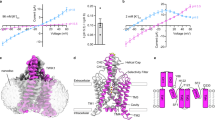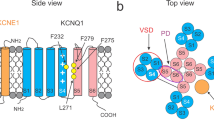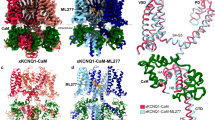Abstract
Large-conductance, voltage- and calcium-activated potassium (BK, or KCa1.1) channels are ubiquitously expressed in electrically excitable and non-excitable cells1,2, either as α-subunit (BKα) tetramers or together with tissue specific auxiliary β-subunits (β1–β4)3,4,5. Activation of BK channels typically requires coincident membrane depolarization and elevation in free cytosolic Ca2+ concentration ([Ca2+]i)6,7, which are not physiological conditions for most non-excitable cells. Here we present evidence that in non-excitable LNCaP prostate cancer cells, BK channels can be activated at negative voltages without rises in [Ca2+]i through their complex with an auxiliary protein, leucine-rich repeat (LRR)-containing protein 26 (LRRC26). LRRC26 modulates the gating of a BK channel by enhancing the allosteric coupling between voltage-sensor activation and the channel’s closed–open transition. This finding reveals a novel auxiliary protein of a voltage-gated ion channel that gives an unprecedentedly large negative shift (∼−140 mV) in voltage dependence and provides a molecular basis for activation of BK channels at physiological voltages and calcium levels in non-excitable cells.
This is a preview of subscription content, access via your institution
Access options
Subscribe to this journal
Receive 51 print issues and online access
$199.00 per year
only $3.90 per issue
Buy this article
- Purchase on Springer Link
- Instant access to full article PDF
Prices may be subject to local taxes which are calculated during checkout




Similar content being viewed by others
References
Kolb, H. A. Potassium channels in excitable and non-excitable cells. Rev. Physiol. Biochem. Pharmacol. 115, 51–91 (1990)
Salkoff, L., Butler, A., Ferreira, G., Santi, C. & Wei, A. High-conductance potassium channels of the SLO family. Nature Rev. Neurosci. 7, 921–931 (2006)
Uebele, V. N. et al. Cloning and functional expression of two families of beta-subunits of the large conductance calcium-activated K+ channel. J. Biol. Chem. 275, 23211–23218 (2000)
Brenner, R., Jegla, T. J., Wickenden, A., Liu, Y. & Aldrich, R. W. Cloning and functional characterization of novel large conductance calcium-activated potassium channel beta subunits, hKCNMB3 and hKCNMB4. J. Biol. Chem. 275, 6453–6461 (2000)
Behrens, R. et al. hKCNMB3 and hKCNMB4, cloning and characterization of two members of the large-conductance calcium-activated potassium channel beta subunit family. FEBS Lett. 474, 99–106 (2000)
Barrett, J. N., Magleby, K. L. & Pallotta, B. S. Properties of single calcium-activated potassium channels in cultured rat muscle. J. Physiol. (Lond.) 331, 211–230 (1982)
Berkefeld, H. et al. BKCa-Cav channel complexes mediate rapid and localized Ca2+-activated K+ signaling. Science 314, 615–620 (2006)
Fodor, A. A. & Aldrich, R. W. Convergent evolution of alternative splices at domain boundaries of the BK channel. Annu. Rev. Physiol. 71, 19–36 (2009)
Schubert, R. & Nelson, M. T. Protein kinases: tuners of the BKCa channel in smooth muscle. Trends Pharmacol. Sci. 22, 505–512 (2001)
Yan, J. et al. Profiling the phospho-status of the BKCa channel alpha subunit in rat brain reveals unexpected patterns and complexity. Mol. Cell. Proteomics 7, 2188–2198 (2008)
Tang, X. D., Garcia, M. L., Heinemann, S. H. & Hoshi, T. Reactive oxygen species impair Slo1 BK channel function by altering cysteine-mediated calcium sensing. Nature Struct. Mol. Biol. 11, 171–178 (2004)
Gessner, G. et al. BKCa channels activating at resting potential without calcium in LNCaP prostate cancer cells. J. Membr. Biol. 208, 229–240 (2006)
Egland, K. A. et al. High expression of a cytokeratin-associated protein in many cancers. Proc. Natl Acad. Sci. USA 103, 5929–5934 (2006)
Kobe, B. & Kajava, A. V. The leucine-rich repeat as a protein recognition motif. Curr. Opin. Struct. Biol. 11, 725–732 (2001)
Bella, J., Hindle, K. L., McEwan, P. A. & Lovell, S. C. The leucine-rich repeat structure. Cell. Mol. Life Sci. 65, 2307–2333 (2008)
Kunzelmann, K. Ion channels and cancer. J. Membr. Biol. 205, 159–173 (2005)
Cambien, B. et al. Silencing of hSlo potassium channels in human osteosarcoma cells promotes tumorigenesis. Int. J. Cancer 123, 365–371 (2008)
Bloch, M. et al. KCNMA1 gene amplification promotes tumor cell proliferation in human prostate cancer. Oncogene 26, 2525–2534 (2007)
Weaver, A. K., Liu, X. & Sontheimer, H. Role for calcium-activated potassium channels (BK) in growth control of human malignant glioma cells. J. Neurosci. Res. 78, 224–234 (2004)
Xia, X. M., Zeng, X. & Lingle, C. J. Multiple regulatory sites in large-conductance calcium-activated potassium channels. Nature 418, 880–884 (2002)
Horrigan, F. T. & Aldrich, R. W. Coupling between voltage sensor activation, Ca2+ binding and channel opening in large conductance (BK) potassium channels. J. Gen. Physiol. 120, 267–305 (2002)
Ma, Z., Lou, X. J. & Horrigan, F. T. Role of charged residues in the S1–S4 voltage sensor of BK channels. J. Gen. Physiol. 127, 309–328 (2006)
Bao, L. & Cox, D. H. Gating and ionic currents reveal how the BKCa channel’s Ca2+ sensitivity is enhanced by its β1 subunit. J. Gen. Physiol. 126, 393–412 (2005)
Wang, B., Rothberg, B. S. & Brenner, R. Mechanism of β4 subunit modulation of BK channels. J. Gen. Physiol. 127, 449–465 (2006)
Horrigan, F. T. & Ma, Z. Mg2+ enhances voltage sensor/gate coupling in BK channels. J. Gen. Physiol. 131, 13–32 (2007)
Yang, H. et al. Activation of Slo1 BK channels by Mg2+ coordinated between the voltage sensor and RCK1 domains. Nature Struct. Mol. Biol. 15, 1152–1159 (2008)
Thurm, H., Fakler, B. & Oliver, D. Ca2+-independent activation of BKCa channels at negative potentials in mammalian inner hair cells. J. Physiol. (Lond.) 569, 137–151 (2005)
Kim, H. M. et al. Structural diversity of the hagfish variable lymphocyte receptors. J. Biol. Chem. 282, 6726–6732 (2007)
Acknowledgements
We are grateful to I. Pastan and X. F. Liu for the generous gift of LRRC26 antibody and plasmids. We thank J. Trimmer for discussion and W. Li, L. Scott, J. Greeson, X. Chen and H. Liu for reading the manuscript. We thank A. Hall, H. Cha and U. Bagaria for research assistance. Mass spectrometry was performed at the UC Davis Proteomics Facility. J.Y. acknowledges postdoctoral fellowship support from the American Heart Association.
Author information
Authors and Affiliations
Contributions
J.Y. performed the experiments. J.Y. and R.W.A. designed the research, analysed the data and wrote the paper.
Corresponding author
Ethics declarations
Competing interests
The authors declare no competing financial interests.
Supplementary information
Supplementary Figures
This file contains Supplementary Figures 1-7 with legends. (PDF 1266 kb)
Rights and permissions
About this article
Cite this article
Yan, J., Aldrich, R. LRRC26 auxiliary protein allows BK channel activation at resting voltage without calcium. Nature 466, 513–516 (2010). https://doi.org/10.1038/nature09162
Received:
Accepted:
Published:
Issue Date:
DOI: https://doi.org/10.1038/nature09162
This article is cited by
-
Upregulation of Beta4 subunit of BKCa channels in the anterior cingulate cortex contributes to mechanical allodynia associated anxiety-like behaviors
Molecular Brain (2020)
-
Calcium- and voltage-gated BK channels in vascular smooth muscle
Pflügers Archiv - European Journal of Physiology (2018)
-
BKIP-1, an auxiliary subunit critical to SLO-1 function, inhibits SLO-2 potassium channel in vivo
Scientific Reports (2017)
Comments
By submitting a comment you agree to abide by our Terms and Community Guidelines. If you find something abusive or that does not comply with our terms or guidelines please flag it as inappropriate.



